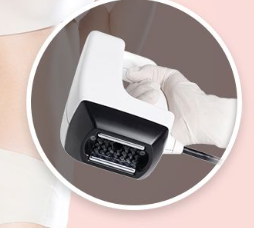Understanding the Science: HIFU vs. RF Technology
Before we compare devices, let's understand how these technologies actually work.
HIFU Technology HIFU uses focused ultrasound energy to target the SMAS (Superficial Musculoaponeurotic System) layer—that's the deep structural layer that surgeons work with during facelifts. The energy creates controlled micro-injuries that trigger your body's healing response, stimulating fresh collagen production for natural tightening and lifting.
Ulthera (Ultherapy) is the gold standard here, with FDA approval and millions of treatments performed worldwide. The clinical data backing its effectiveness is solid.
RF (Radiofrequency) Technology RF takes a different approach, using radiofrequency energy to heat the dermal layer of your skin. Thermage, the most well-known RF device, delivers controlled heat to remodel existing collagen and improve overall skin quality. It's particularly effective for refining texture, minimizing pores, and smoothing fine lines.
The Key Difference: HIFU goes deeper (targeting structural support), while RF focuses on the skin's surface layers (improving quality and texture).
What Home HIFU Devices Actually Deliver
home skin care devices are designed with safety as the top priority, which means they operate at much lower energy levels than professional equipment. This makes them relatively safe for self-use, but it also significantly limits their capabilities.
What you might notice:
Immediate skin hydration and slight firmness
Temporary tightening effect
Improved skin texture for a few days
What you won't get:
Deep structural changes to the SMAS layer
Significant jawline lifting
Long-term collagen remodeling
Results lasting more than a few weeks
Research indicates that while low-power home skin care devices can provide minor skin benefits, they simply don't have the energy output needed for meaningful collagen regeneration or structural lifting. Think of them as a nice supplement to your skincare routine rather than a replacement for professional treatments.
Why Professional Ulthera Still Leads the Pack
Ulthera's main advantage isn't just its power—it's the precision. The "See & Treat" technology lets practitioners see exactly where they're delivering energy in real-time, ensuring optimal placement and results.
What Ulthera can achieve:
Noticeable jawline definition and lifting
Reduction of double chin appearance
Improvement in cheek sagging
Smoother neck contours
Results that typically last 12-18 months
The treatment is backed by extensive clinical studies and FDA clearance, making it a reliable choice for patients seeking significant lifting results.
Choosing What's Right for Your Age and Concerns
In Your 20s-30s: If you're just starting to notice minor changes, home devices might be sufficient for maintenance, especially when combined with good skincare. However, even preventive professional treatments can be worthwhile.
Late 30s-40s: As collagen production naturally slows down, professional treatments become more valuable. This is when the investment in Ulthera or Thermage really pays off in terms of visible, lasting results.
50s and Beyond: Significant skin laxity, deep wrinkles, and pronounced sagging typically require professional intervention. A combination approach or customized treatment plan often works best.
Leading dermatological associations, including those at major medical centers, consistently recommend individualized treatment plans based on specific skin conditions and concerns.
Why Expertise Matters
Even the best technology is only as good as the hands operating it. Incorrect energy delivery can lead to disappointing results or, worse, side effects. This is why choosing an experienced practitioner is crucial for professional treatments.
ID Clinic Gangnam has established itself as a leader in professional lifting treatments in Korea, with extensive experience in both Ulthera and Thermage procedures. Their track record with thousands of successful cases makes them a trusted choice for both local and international patients seeking reliable results.
home skin care devices serve a purpose—they're convenient, safe, and can provide minor skin benefits. But they're not miracle workers, and they can't replace the structural improvements that professional treatments deliver.
Professional devices like Ulthera and Thermage have FDA approval, extensive clinical backing, and the power to create meaningful, lasting changes in your skin's structure and appearance.
The smart approach? Choose based on your specific needs, age, and expectations. For maintenance and prevention, home devices can be part of your routine. For real transformation and long-lasting results, professional treatment is the way to go.
If you're considering professional treatment, make sure to consult with experienced practitioners who can assess your individual needs and recommend the most effective approach for your goals.
Home Skin Care Devices vs. Professional Equipment: Is There a Real Difference Between Ulthera and Skincare Devices?
Comparing home HIFU devices with professional treatments like Ulthera and Thermage. We break down the real differences in effectiveness, safety, results duration, and help you decide what's right for your skin.
Understanding the Science: HIFU vs. RF Technology
Before we compare devices, let's understand how these technologies actually work.
HIFU Technology HIFU uses focused ultrasound energy to target the SMAS (Superficial Musculoaponeurotic System) layer—that's the deep structural layer that surgeons work with during facelifts. The energy creates controlled micro-injuries that trigger your body's healing response, stimulating fresh collagen production for natural tightening and lifting.
Ulthera (Ultherapy) is the gold standard here, with FDA approval and millions of treatments performed worldwide. The clinical data backing its effectiveness is solid.
RF (Radiofrequency) Technology RF takes a different approach, using radiofrequency energy to heat the dermal layer of your skin. Thermage, the most well-known RF device, delivers controlled heat to remodel existing collagen and improve overall skin quality. It's particularly effective for refining texture, minimizing pores, and smoothing fine lines.
The Key Difference: HIFU goes deeper (targeting structural support), while RF focuses on the skin's surface layers (improving quality and texture).
What Home HIFU Devices Actually Deliver
home skin care devices are designed with safety as the top priority, which means they operate at much lower energy levels than professional equipment. This makes them relatively safe for self-use, but it also significantly limits their capabilities.
What you might notice:
Immediate skin hydration and slight firmness
Temporary tightening effect
Improved skin texture for a few days
What you won't get:
Deep structural changes to the SMAS layer
Significant jawline lifting
Long-term collagen remodeling
Results lasting more than a few weeks
Research indicates that while low-power home skin care devices can provide minor skin benefits, they simply don't have the energy output needed for meaningful collagen regeneration or structural lifting. Think of them as a nice supplement to your skincare routine rather than a replacement for professional treatments.
Why Professional Ulthera Still Leads the Pack
Ulthera's main advantage isn't just its power—it's the precision. The "See & Treat" technology lets practitioners see exactly where they're delivering energy in real-time, ensuring optimal placement and results.
What Ulthera can achieve:
Noticeable jawline definition and lifting
Reduction of double chin appearance
Improvement in cheek sagging
Smoother neck contours
Results that typically last 12-18 months
The treatment is backed by extensive clinical studies and FDA clearance, making it a reliable choice for patients seeking significant lifting results.
Choosing What's Right for Your Age and Concerns
In Your 20s-30s: If you're just starting to notice minor changes, home devices might be sufficient for maintenance, especially when combined with good skincare. However, even preventive professional treatments can be worthwhile.
Late 30s-40s: As collagen production naturally slows down, professional treatments become more valuable. This is when the investment in Ulthera or Thermage really pays off in terms of visible, lasting results.
50s and Beyond: Significant skin laxity, deep wrinkles, and pronounced sagging typically require professional intervention. A combination approach or customized treatment plan often works best.
Leading dermatological associations, including those at major medical centers, consistently recommend individualized treatment plans based on specific skin conditions and concerns.
Why Expertise Matters
Even the best technology is only as good as the hands operating it. Incorrect energy delivery can lead to disappointing results or, worse, side effects. This is why choosing an experienced practitioner is crucial for professional treatments.
ID Clinic Gangnam has established itself as a leader in professional lifting treatments in Korea, with extensive experience in both Ulthera and Thermage procedures. Their track record with thousands of successful cases makes them a trusted choice for both local and international patients seeking reliable results.
home skin care devices serve a purpose—they're convenient, safe, and can provide minor skin benefits. But they're not miracle workers, and they can't replace the structural improvements that professional treatments deliver.
Professional devices like Ulthera and Thermage have FDA approval, extensive clinical backing, and the power to create meaningful, lasting changes in your skin's structure and appearance.
The smart approach? Choose based on your specific needs, age, and expectations. For maintenance and prevention, home devices can be part of your routine. For real transformation and long-lasting results, professional treatment is the way to go.
If you're considering professional treatment, make sure to consult with experienced practitioners who can assess your individual needs and recommend the most effective approach for your goals.















